When the occasion arises to play pickleball beyond the usual doubles game, embracing singles offers a challenging yet rewarding variation. Unlike doubles, where teamwork and shared court coverage are key, singles demand that you cover every inch of your side of the court on your own. This shift not only tests your agility but also sharpens your strategic thinking.
As a pickleball enthusiast, I’ve found that playing singles is not just about physical prowess; it’s a mental game that requires quick decision-making and adaptability. Each point in a singles match is a blend of fun and intensity, pushing you to improve your overall skills. In this article, we’ll delve into the similarities and differences between singles and doubles, offering tips and Pickleball Singles Strategy to refine your singles gameplay. Embracing singles is not just a test of endurance; it’s an important journey towards becoming a more versatile player.
Table of Contents
What Is a Singles Game Exactly?
In pickleball and other paddle sports, a singles game is a unique experience, differing simply in numbers but vastly in gameplay compared to a doubles game. It's not just about playing 1 v 1 instead of 2 v 2; it's about mastering a more individualized and taxing challenge.
When you play singles, you are solely responsible for your entire side of the court, demanding not just skill but significant physical stamina and agility.
This format of the game is akin to tennis, where quick reactions and sprints are crucial, and pickleball’s characteristic lower bounces and softer touches mean constant vigilance and adaptability. The rules of singles may seem easier to get, but the game is especially challenging regarding endurance and strategy. In contrast to doubles, where efforts are shared, singles require a player to cover all aspects of the game.
Furthermore, there is however another type of singles play known as skinny singles, which removes some of the cardio demands from the court, offering a different way to enjoy the game. This variation still requires strategic play and quick decision-making but focuses more on skill than endurance.
Skinny Singles in Pickleball
Skinny singles in pickleball is a fascinating form of the game that divides the playing court into half, making it easier for players to cover ground. This variation is played by splitting the court along the centerline or using the diagonal service courts as the playable area. It's a unique way to enjoy pickleball, where you're still playing one vs. one, but with a twist.
Oddly enough, this style of play resembles doubles more than it does conventional singles. In skinny singles, you’re responsible for just half of the court, similar to many situations in doubles play. However, when it comes to serving, it follows the same format as standard singles pickleball.
You serve until a fault occurs, then it’s a side out, a term in pickleball that means losing possession of serving, and the play going to the opposite player or team. This blend of rules and court setup makes skinny singles an exciting and strategic choice for players looking to mix up their game.
Skinny singles in pickleball offer a different dynamic from the usual doubles format. In traditional doubles, server 1 would hand serving duties over to server 2 after losing a point. However, in skinny singles, the gameplay is more focused and personal.
While you probably won’t see skinny singles in a tournament, it’s a great option for those who just want to have a good time or wish to hone in on training a specific skill.
Pickleball is celebrated for its versatility, and skinny singles is a testament to that. Picklers can choose between a team-centered game, with help from a partner, or a more solitary lone workout where you can run drills.
Skinny singles, of course, allow you to cut up and make pickleball a more leisurely competition with one friend, or to get to work on improving a part of your game in a more focused setting. It’s the perfect blend of fun and skill enhancement.
How to Play Singles Pickleball?
When it comes to pickleball singles, the game follows the same set of rules as in doubles, but with a crucial twist. The main difference lies in playing alone on one side of the court. You won’t have a partner to lean on, which means every shot and strategy depends solely on you. While the basics of the game remain intact, playing singles requires a heightened sense of awareness and agility.
In singles, your ability to cover the entire court becomes paramount. We’ll look into these technical differences in more detail later, exploring how singles play requires a unique approach to shot selection, movement, and game tactics.
Court Positioning in Singles Play

In pickleball singles, the approach to serving is the same as in doubles, but with a greater emphasis on strategic positioning. You must be standing behind the baseline to serve, and the first serve is made from the right side of the court.
As the game progresses, players alternate the serving side based on their score – from the right when the score is even, and from the left when it’s odd. Unlike in doubles, where teamwork dictates positioning, in singles, you should aim to quickly get up to the non-volley zone, or kitchen, as soon as possible after your serve.
This position not only gives you control over the net but also allows you to effectively cut off your opponent’s angle shots, making it a crucial tactic in singles pickleball.
Court dimensions
Unlike in tennis, where the singles court is distinctly marked within the larger doubles court, pickleball maintains a uniform court size for both singles and doubles play.
In pickleball singles, you have the entire court to yourself, without any alterations in dimensions or sidelines as seen in tennis. This means whether you play singles or doubles, the court dimensions remain at 20′ by 44′, offering 440 square feet of space. This uniformity simplifies the transition between playing styles, giving you, as a singles player, the advantage of all this space to yourself. It allows for a wide range of movement and strategic positioning, essential for the dynamic play of pickleball singles.
Equipment for the Game
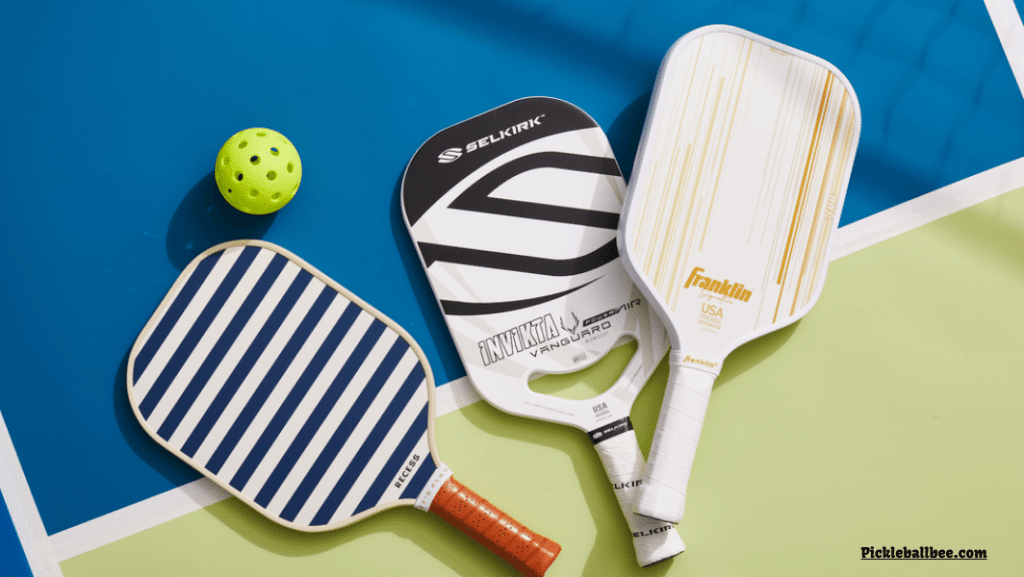
When gearing up for pickleball singles, it’s reassuring to know that the equipment needed is identical to that used in doubles. This includes the balls, which are the same for both formats, and the court dimensions, net height, and other essentials remain consistent. In terms of personal gear, you’ll need a good quality paddle, crucial for both control and power in your shots. A unique bonus of playing singles is that you won’t have to worry about your outfit clashing with a teammate.
You can Check Out the Best Pickleball Paddles Here
You can go crazy if you want when it comes to choosing clothes for your game. Just make sure your shirt doesn’t match the color of the ball to avoid any confusion during play. In singles pickleball, your style can be as unique as your gameplay.
How Is a Singles Pickleball Game Played?
In singles pickleball, grasping a few key rules and serving strategies significantly impacts your gameplay. There are 3 things every player must know to excel. Firstly, each player serves from the right-hand side of the court at the start. When the server wins their first serve, the dynamic changes and the next serve is made from the left-hand side.
This alternation continues, with the server switching between the right and left sides after each point, until a fault occurs, and the serve then goes to the opponent.
To keep on top of the game, it’s crucial to understand these 3 simple concepts. Remember, the score dictates the side from which you serve: even scores from the right side and odd scores from the left. Maintaining this sequence helps keep the flow of the game intact and puts you in a good spot for strategic play.
Pickleball singles rules
As we have discussed, pickleball has been predominantly played as a doubles game. However, the trend is shifting, with singles becoming increasingly popular these days, particularly among younger players and those transitioning from tennis backgrounds.
Traditionally, singles in pickleball used to involve very short bursts of action, often limited to 3-4 shots back and forth. But, as players start physically training more and refining their techniques, singles gameplay is evolving into something different, characterized by longer and more exciting rallies. This shift in playstyle is a testament to the game’s growing versatility and the increasing skill level of players who are now taking singles pickleball to new heights of competition and entertainment.
Server Rules in Singles
In pickleball singles, server rules closely mirror those in doubles. The first serve is always taken from the right-hand side of the court. Deciding who serves first is typically determined by traditional methods, such as a coin toss. A unique aspect of singles is the server’s movement after a successful point. If the server wins the rally or scores an ace, they then serve again, but this time they move to the left-hand side of the court.
They continue serving from alternate sides, switching between the right and left after each point, until they lose the rally or commit a fault. In case of a fault, the service moves to the opponent, commonly referred to as a side-out.
As the game progresses, a simple tip to remember where to serve from: if your score is an even number, you serve from the right; if it’s odd, you serve from the left. Understanding and utilizing these server rules can significantly influence your strategy and success in singles pickleball.
Scoring in Singles Play
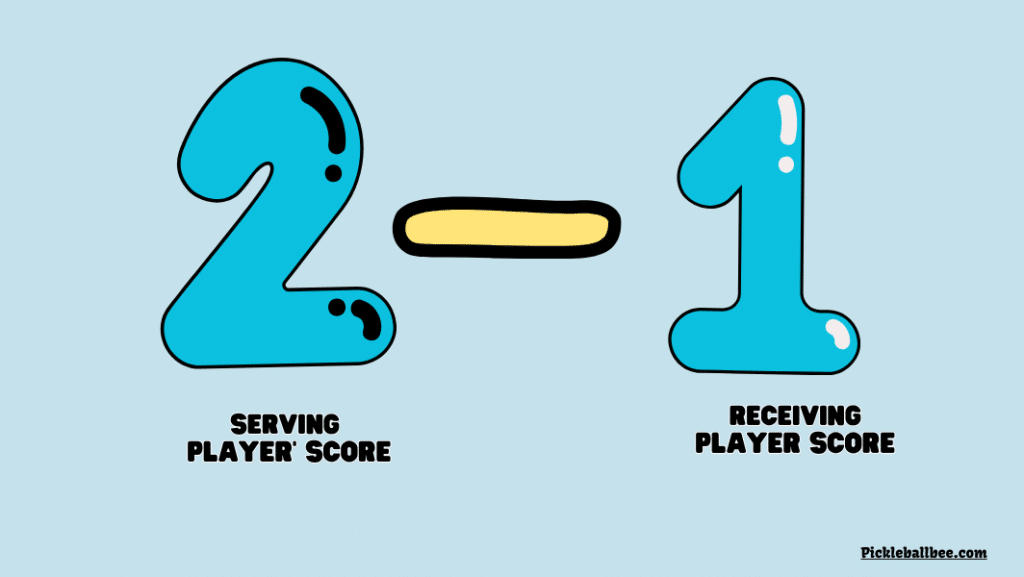
Scoring in singles pickleball is notably easier to grasp than in doubles, primarily because there is no third number that usually indicates which teammate is serving; this element is not used in singles. Instead, the score simply shows the points each player has won, for example, 2–1. This format tells you the person with the higher score is currently serving, as the server’s score is always called first. The simplicity of scoring in singles is evident. Just as in doubles, a player must earn 11 points to win the game, and importantly, they must be ahead by two points.
This clear-cut scoring method allows players to easily track their progress and strategize accordingly in the fast-paced environment of a singles pickleball game.
Volleys and the Double Bounce Rule
In the singles game of pickleball, the volley rules are identical to those in doubles. This means there is no volleying in the kitchen or non-volley zone. The fundamental double bounce rule also applies here. It means the player receiving the serve must allow the ball to bounce before returning it. After the ball is returned, the server must also let it bounce once. Once this sequence is completed, the game intensifies, and shots can be volleyed back and forth without bouncing.
This rule ensures a fair and engaging start to each point, making the game more about skill and less about quick advantages. Adhering to these rules in singles pickleball not only keeps the play regulated but also adds a strategic depth to how you approach each volley and return.
Line Calls in Singles Play
In pickleball singles, line calls are managed similarly to doubles. If the ball lands outside of the lines, and you can see a space between the ball and the line, the correct call is “out.”
However, the spirit of the game emphasizes fairness, so the benefit of the doubt is always given to the opponent. If you aren’t sure whether the ball is in or out, the decision goes in your opponent’s favor. This rule upholds the integrity of the game and promotes a respectful and sportsmanlike environment.
It’s a key aspect of pickleball that not only governs the physical boundaries of play but also reinforces the game’s underlying ethos of fairness and mutual respect among players.
Difference between a Singles and Doubles Game?
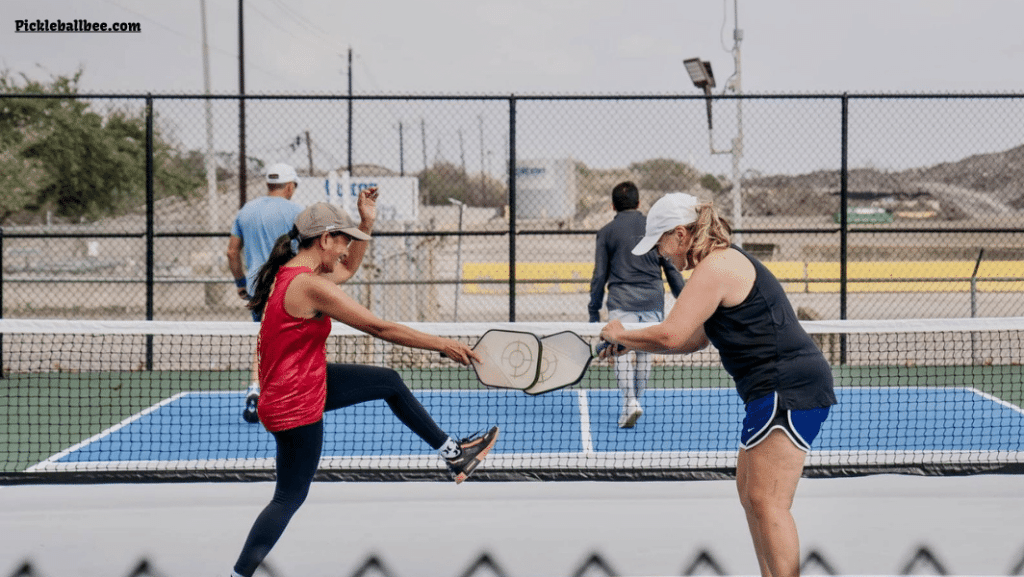
Many people assume that singles and doubles in pickleball are played the same, with the only distinction being the number of players on the court – two in singles and four in doubles. However, two key things delineate these formats.
The biggest difference lies in the serving sequence and scoring. In singles pickleball, each player gets one serve until a fault occurs, and the score is kept using just 2 numbers. This simplicity makes tracking the game straightforward for both players and spectators.
On the other hand, in doubles, the format is slightly more complex. Each player on a side serves once, and this happens consecutively. Scoring in doubles involves 3 numbers to track the progress of the game, helping identify who the servers are at any point in time.
This variation adds an extra layer of strategy to doubles play, as players need to be more aware of the serving order and adjust their gameplay accordingly. Understanding these differences is crucial for players transitioning between singles and doubles games, as it influences the overall strategy and flow of the match.
Key differences between pickleball singles vs doubles
The main difference between singles and doubles in pickleball lies in the player dynamics on the court.
In singles, you are alone, with no teammate to rely on, which means you have to cover the entire court by yourself. This is both physically demanding and requires a high level of speed and agility. It also demands a lot of strategy and precise shot placement.
Secondly, in singles, the play is less concentrated near the net. It’s beneficial for players to get to the kitchen line, but it’s also easy for one player to become trapped in the backcourt and unable to move effectively. This aspect makes the game more open, with a tendency towards longer shots, as players are covering their side of the court and are more likely to hit more groundstrokes, as opposed to blocking shots and creating angles.
Social Dynamics and Popularity
Another important difference is in the social aspect. Singles can feel less friendly compared to playing doubles. When played recreationally, pickleball is known to be a super social game, and the doubles format naturally lends itself to this quality. With four players bunched up on a small court, there’s plenty of opportunity for conversation and laughs.
The recent surge in the popularity of pickleball has also brought a lot of pressure on court time. Doublesplay allows twice as many people to play at the same time, which is another reason why it’s often the favored format in most casual settings.
Court Utilization and Player Involvement
Lastly, in doubles, each player’s involvement in the game is more evenly distributed due to shared responsibilities on the court. This distribution often leads to a more dynamic and interactive game experience. In contrast, singles require a player to be constantly alert and involved in every aspect of the game. This heightened involvement in singles can be both a challenge and an exhilarating experience, pushing players to develop a more comprehensive understanding of pickleball tactics and skills.
Advantages of Playing Singles
There are numerous benefits to playing singles in pickleball, even for those who prefer the doubles format. A key advantage is the physical aspect: singles play is a great workout. Players in a singles match take significantly more steps per hour and, as a result, burn more calories.
Studies show that players take around 3,322 steps during a game of singles pickleball, in contrast to about 2,790 steps in doubles. That’s roughly 16% more physical activity when playing singles.
Moreover, pickleball singles serve as an excellent way to hone your overall skills. It requires hitting groundstrokes from the backcourt and making shots on the run, which enhances your agility and precision. When you return to playing doubles, you’ll find that covering half of the court will feel like a breeze compared to the extensive coverage required in singles. This skill enhancement in singles can significantly elevate your overall game, making you a more versatile and competent player in both formats.
Pickleball Singles Strategy
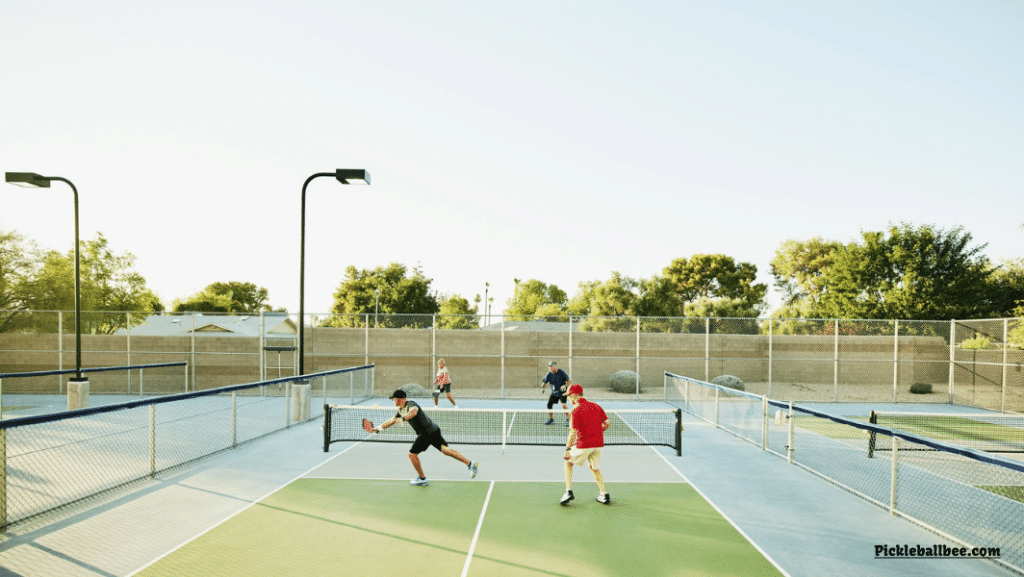
In pickleball singles, a key strategy involves where and how you serve. Serving near the middle T of the court allows you to position yourself quickly for the next shot. This tactic also helps prevent your opponent from getting too much angle on their return. Another effective technique is to serve deep, which keeps your opponent back behind the baseline and forces them to make a longer return. However, take care not to go out of bounds. As the receiver, focus on hitting an arcing return to gain control of the rally.
Post-serve, your movement is crucial. After you hit your shot, move to a central position to avoid leaving a large space for your opponent to aim for. Additionally, always aim for your opponent’s weak side, usually their backhand, and use their momentum against them. If you see them moving one way, strategically hit your shot the other way. This technique can be effective, as it’s difficult to reverse momentum quickly in pickleball. These strategies are about understanding and exploiting the court space and your opponent’s movement, turning the singles game into a chess match of skill and wit.
Winning Strategies for Singles
Identify Opponent’s Weaknesses: Start by observing your opponent’s gameplay to spot their vulnerabilities early on. This could be their backhand, mobility, or reaction to fast shots.
- Be Aggressive: Take control of the game by being more assertive with your shots. Don’t hesitate to go for winners when the opportunity arises.
- Master Deep Returns: Focus on making your returns deep, forcing your opponent to move back, which can disrupt their strategy and create scoring opportunities for you.
- Quickly Adapt to the Game: Settle into the court swiftly, adjusting to the pace and style of the singles game. This helps in maintaining rhythm and control.
- Maintain a Positive Attitude: Stay positive and resilient, regardless of the game’s progress. A positive mindset can significantly impact your performance and decision-making.
How skinny singles pickleball works
Skinny singles is a refreshing alternative to standard pickleball, rapidly gaining popularity on courts across the US. This format appeals to many players who might usually avoid traditional singles due to its intensity. In skinny singles, players enjoy a more contained version of the game, making it easier to manage and allowing them to get on board with the singles format.
It’s not just for competitive play; skinny singles is also used effectively as a great drill in pickleball training sessions. This innovative style maintains the core of pickleball while making it accessible and enjoyable for a broader range of players.
Singles vs Skinny Singles
The difference between traditional pickleball singles and skinny singles is quite simple yet significant.
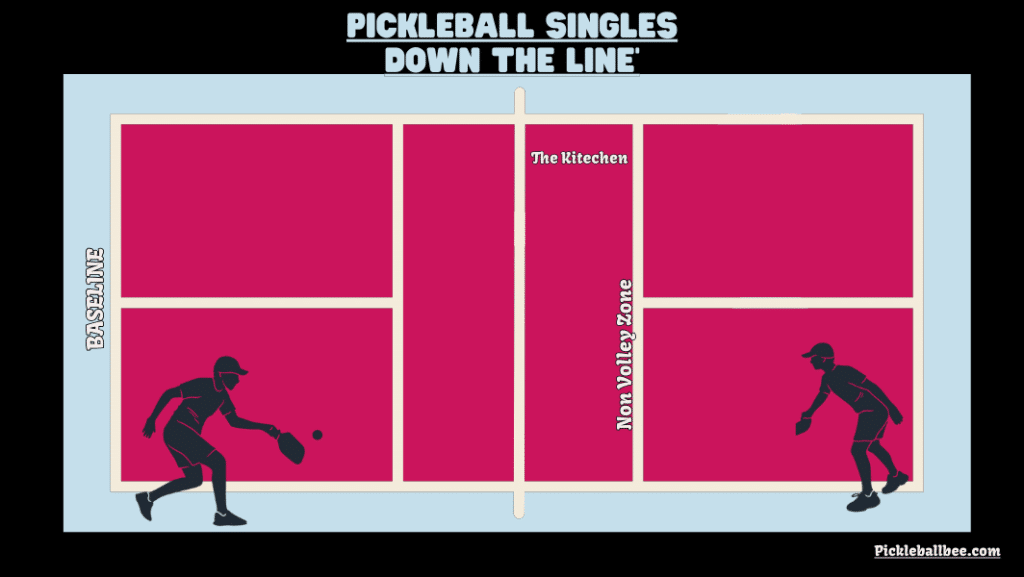
In regular pickleball singles, players use the entire court, which involves a lot of ground to cover and demands high physical endurance. Skinny singles, on the other hand, is played using only half the court. How the court is divided into skinny singles makes it interesting. There are two ways to split the court in this variation. In the “Down the line” method, you and your opponent play directly across the net from each other, changing sides with each serve based on the score. The “Crosscourt” method involves playing in diagonal courts, switching to the opposite diagonal with each serve.
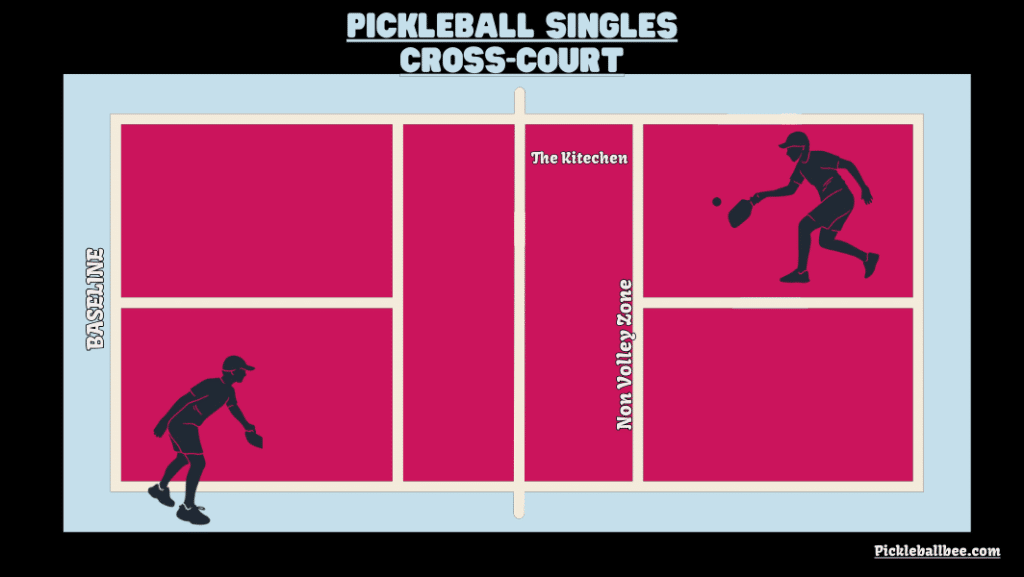
This variation of pickleball removes the challenge of covering the entire court by yourself, making it a less intense workout. It makes the game a little more like doubles, where you are responsible for only a portion of the court. In skinny singles, players often use the same shots and strategies as they would typically use in the doubles game, making it an ideal format for those looking to ease into the singles format or enhance specific skills in a more controlled environment.
Skinny singles pickleball rules
Skinny singles pickleball offers a twist on the traditional game, with a court size that’s half the regular playing area. This format uses only half of the court, essentially reducing the standard 440 square feet to just 220 square feet or 10’ by 22’. This change in court size alters the dynamics of the game, focusing play on agility and precision within a smaller area. The reduction of the court to half its usual size is what primarily differentiates skinny singles from the traditional singles format, making it more accessible and less physically demanding.
Skinny Singles Variations
One interesting twist within this format is ‘Slender singles’, a variation of skinny singles. In slender singles, the actual court size is further reduced by 20%, achieved by removing two feet of space on either side of the already halved court. This makes for an even easier game, reducing some of the challenges that might intimidate beginners or casual players, often referred to as pickleheads. Both skinny and slender singles are excellent options for players looking to focus on specific skills, such as shot accuracy and quick reflexes, in a more manageable playing space.
Playing is the Best Way to Learn Singles
While singles and doubles in pickleball share fundamental similarities, the transition between the two can be an enlightening experience. In singles, the game is scored differently, and what is expected from players varies significantly. This difference, however, is small and relatively easy to adjust to for seasoned players.
Playing singles is a fantastic way to showcase your skills and adaptability, regardless of your skill level. It pushes you to rely solely on your abilities, making every point a testament to your prowess on the court.
The most important aspect to remember when learning singles pickleball is that the best way to learn is by getting out on the court and playing. Theoretical knowledge of the rules is essential, but real mastery comes from applying these rules in live gameplay. When you’re out on the court, each rally becomes a learning opportunity, helping you pick up the nuances of each point as you go. This hands-on approach is far more effective than any written guide or instructional video could ever be.
Practice Makes Perfect
For those new to pickleball or transitioning from doubles, the initial games might feel challenging. But with practice and dedication, you’ll find yourself growing more comfortable and skilled with each match.
If you’ve never played singles before, now is the perfect time to start. After your first game, you’ll likely see pickleball in a new light. Coming back to theoretical guides or strategy discussions after experiencing the game firsthand can provide even deeper insights, making these resources more valuable. Over time, you’ll find yourself understanding the rules like a pro, ready to take on any opponent that comes your way in singles pickleball.
conclusion
As our guide to pickleball singles draws to a close, it’s time to reflect on the journey. After hearing our take on playing singles, you might be inspired to give it a go. For those who are already avid players, transitioning to singles could open a new dimension in your game. We’d love to hear your thoughts and advice for those wanting to try singles for the first time. Feel free to share your experiences on our social media; your insights could be invaluable to fellow enthusiasts.
Meanwhile, the next time you’re looking for a game, don’t hesitate to try out singles. Whether you’re a seasoned player or just starting, singles pickleball offers a unique challenge that can significantly enhance your skills. Check out the sessions at your nearest court and immerse yourself in the exciting world of singles pickleball. Remember, each game is a step towards mastering this dynamic sport.
FAQs:
-
How many servings are in a single pickleball?
In pickleball singles, each player is allowed one serve per turn. The server continues to serve until it commits a fault. If the server wins the rally, they switch sides and serve from the alternate side of the court, continuing this pattern until a fault occurs, at which point the serve passes to the opponent.
-
Can you drop the ball to serve in pickleball?
Yes, in pickleball, the rules now allow for a drop serve. This method involves gently dropping the ball onto the court, letting it bounce, and then hitting it for the serve. This change offers players an alternative to the traditional underhand serve, providing more flexibility in serving techniques. Introduced as a provisional rule, the drop serve has been officially integrated into the game.
-
Can you bounce the ball before you serve in pickleball?
Yes, in pickleball, you are allowed to bounce the ball before serving. This technique, known as a drop serve, involves gently dropping the ball onto the court, letting it bounce once, and then hitting it for the serve. It offers an alternative to the traditional underhand serve, adding variety to serving styles.


